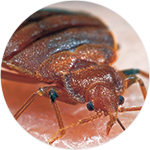
Tips to Prevent Bed Bugs while Traveling this Spring
March and April mean increased travel for college students, families and individuals planning spring break vacations. Travel can increase the chance of bed bug exposure, especially overseas, as they cling to clothes, hide in luggage and can take up residence in hotels.
Tips for hotel stays:
-
If your travel plans include a hotel stay, check for recent bed bug complaints by previous guests in one of the hotel registries. The Bed Bug Registry is an online site where hotel guests can report bed bug infestations. Look for patterns in complaints, date of complaints and whether or not actual bed bugs were reported versus bites. The guest reports and hotel responses are not independently verified. Understand the limitations of the information posted.
-
After checking in at your selected hotel, check for bed bugs in your room. A good flashlight can be helpful in inspecting for these pests. You will focus your inspection on the bed area. Stowe your luggage away from the bed until the inspection is complete.
-
At a minimum, check around the bed, nightstand, head board and bed skirt for signs of bed bugs. If possible, lift the head board off the wall to inspect behind it. Check under sheets, bed skirt, and underneath and behind the night stand. Look at the piping around the mattress. You will be looking for live insects, shed bed bug skins and peppery fecal spots which can be found in areas where the bed bugs congregate. Bed bugs are very flat and can be found in furniture cracks and crevices and folds of linens and bed skirts.
-
If bed bugs are found, asked to be moved to another room. Preferably the room should be one that is not next to the room where the bed bugs were found. If you find bed bugs in your newly assigned room, ask to be moved to another hotel.
-
If no bed bugs are found, it is a good idea not to move clothes into dresser drawers. Moving your clothes can increase the chance of being infested with bed bugs.
-
Upon returning from your trip, consider keeping your suitcase in a garage and unloading clothes directly into your clothes dryer for a precautionary treatment. The heat of a clothes dryer is very effective at killing bed bugs. All stages of bed bugs can be killed by placing clothes in a dryer for a minimum of 20 minutes on the high heat setting. If clothes are wet when placed in the dryer, the 20 minutes of “heat time” starts after the clothes are dry. Continue to expose clothes to the dryer heat for additional 20 minutes past the time they are dry.
Tips for returning college students or others who have encountered bed bugs:
Some universities have experience bed bug problems in dorms. In addition, bed bugs can also be found in apartment complexes not associated with the university. Students should take care not to transport bed bugs home. Keeping suitcases in the garage and moving clothes immediately into the dryer are advised. Use plastic bags to transport the clothes from the suitcase to the dryer. Students should avoid bringing blankets or pillows home unless they are also placed into the dryer before using at home.
It is important to be aware of the bed bug issue and inspect for bed bugs. However, bed bugs should not prevent people from traveling whether it is for vacation, business or reuniting with family. The majority of hotel stays do not result in bed bug problems. A few minutes of inspection time can be valuable in recognizing any issues, preventing bites and the transport of bed bugs home.
Traveler’s Tips for Avoiding Bed Bugs during Spring Break Travel Pest Control and Exterminators in the Midwest
Serving...